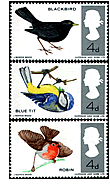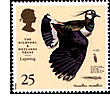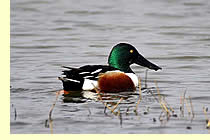





JANUARY 2004, LONDON

The birding gods were good to me on my birthday weekend. There've been rumors all week of a true winter storm heading toward southeast England. We listen to such rumors and tend to believe them. Like most civilized nations, England tolerates weather forecasters but doesn't expect accuracy. Rumors based on your grandmother's rheumatism prove more reliable. This time the rumors were premature. Saturday dawned cold, clear and windless.
On the morning dog walk Bridget and I saw two Great Spotted Woodpeckers. Bridget was sniffing through the bushes so she didn't really pay attention to the birds. The "Great Spot" is similar to the American Hairy, but smaller despite its misleading name. The Redwings were buzzing about the barren plane trees and lower bushes. The buzz is their alarm call. The Redwing is a dark, streaked Thrush come south from Scandanavia for the winter.
Along the edge of upper Telegraph Hill Park where brush is densest I heard the baritone phizzing of Greenfinches. They sound very much like a musical version of the Savannah Sparrow. Chaffinches were near the entry gate of the park, in their favourite bushes. Their sweet little chips sound much like the chip notes of our House Finches. The finches here are large by American standards, closer to Cassin's in size, gigantic compared to American Goldfinches.
There are at least five small flocks of House Sparrows scattered about our neighborhood in Lewisham. One of them lives along the south edge of Telegraph Hill where there must be a feeder I can't see beyond the high garden fences. I hear them every day when it's not raining or windy. They were quite vocal this morning. Surely this species is doing much better in France and the U.S. than here in England where it's threatening to become the non-English Sparrow. We keep our backyard feeder filled but there has never been a single sparrow show up, the nearest flock being at least four blocks away. Their near relative, the Tree Sparrow, is having an even harder time surviving in today's rural England.
 Our feeder draws Robin, Blue and Great Tits. Picking around on seeds that drop to the ground will be Blackbirds, clumsy Wood Pigeons and an occasional Chaffinch or the secretive Dunnock. The Winter Wren ignores the seeds but is drawn to the action of the other birds, and will hop through the dense bushes. Our garden is too enclosed for the larger birds. Magpies, Carrion Crows and Starling are plentiful but won't risk coming down to our feeder where shrubs and fences are so near, and the many house cats are clearly seen from above. The large, clumsy Wood Pigeons seem careless as they pick up the fallen seeds from the grass, not caring that there is barely space for them to take off.
Our feeder draws Robin, Blue and Great Tits. Picking around on seeds that drop to the ground will be Blackbirds, clumsy Wood Pigeons and an occasional Chaffinch or the secretive Dunnock. The Winter Wren ignores the seeds but is drawn to the action of the other birds, and will hop through the dense bushes. Our garden is too enclosed for the larger birds. Magpies, Carrion Crows and Starling are plentiful but won't risk coming down to our feeder where shrubs and fences are so near, and the many house cats are clearly seen from above. The large, clumsy Wood Pigeons seem careless as they pick up the fallen seeds from the grass, not caring that there is barely space for them to take off.
As Bridget and I turned toward home from the park a single Mistle Thrush was making its insect-like buzz from behind a limb in one of the taller plane trees. And then I saw a hefty outline move onto a limb overhead. It was the Jay, a bird that nests in the nearby overgrown Nunhead Cemetery but is usually difficult to see. The obvious and noisy Corvids hereabouts are the Magpie [Pica pica] and Carrion Crow. In small towns and some farm areas you get the very talkative flocks of the stubby Jackdaws. Usually you hear their sharp, nasal "pwok, pwok powk" cries before you see them. "Jacks" will roost in castles, cathedrals or woodlands. Rooks in England are strictly rural birds needing large dense woods for their communal roosting. The dark gray, bare skin at the base of a Rook's beak is its defining field mark. In some cases you get roosting sites with Crows and Jackdaws and Rooks all mixed together. The other two English Corvids are scarce. The Common Ravens (same species as America, for now) are found in remote coastal areas of Cornwall, Wales and into the mountains of Scotland. The famous Ravens of The Tower in central London have their wings clipped to keep them in place. They perform tough-looking imitations of bird thuggery for the tourists.
The Red-billed Chough ["chuff"] is found in limited areas of Wales and Ireland, plus a few pairs have re-colonized The Lizard [peninsula] in south Cornwall. It was there, on a cliffside reminiscent of Point Reyes around Chimney Rock, I saw my first Chough. This species is very particular of its habitat, needing livestock pasture next to steep ocean cliffs, so ocean resort development and the limiting of coastal cattle farming has nearly wiped out the Chough. Preservation groups are bringing back the cattle and sheep and restoring coastal pasture. So Cornwall, which has three Chough on its coat of arms, once again has a small population of the bird. Gilbert White, the great 18th Century naturalist, tells us this Chough was once common all along the southern coast of England.
Fairlop
Eating breakfast on the train like a typical Londoner, I left New Cross Gate for London Bridge, then onto the Jubilee Line of the Tube east to its end at Stratford (this is not Shakespeare's Stratford). From there even further northeast on the Central Line toward Woodford via Hainault. Off at Fairlop and then a couple hundred yards walk east to the entry of Fairlop Waters, a local park with a golf course and two old rock quarries turned into fishing and sailing lakes (no motorboats). At this point I am less than 11 miles from Saint Paul's Cathedral which is the heart of the London birding circle, anything within 20 miles of Saint Paul's is considered a London bird.
I've come to Fairlop for a particular rare warbler that would be a world lifer, but it is generally a rewarding birding spot. One cold spring day two years ago I came here and saw and heard my first Skylarks. The park has some groves of trees planted about twenty years ago, but much of it is rolling grassland that does not get mowed. Perfect lark habitat. The male Skylark is a testosterone driven aerialist with a non-stop need to sing. I have timed songs longer than 3 minutes. There are recordings of male songs several times that long. This singing takes place at the limit of binocular range, straight overhead. The bird will fly back and forth like an Allen's Hummingbird, then drop swiftly a few hundred feet and then climb as quickly, then hover on fluttering wings like a Kestrel. All this at great height. The best way to watch is simply to lie on your back.. The song is a mix of trills, warbled notes, staccato runs of different notes and slurred calls, all seemingly with no breathing space in between. The notes are high pitched and flutey like a Meadowlark, giving a hint to how this American Icterid got its "lark" misnomer. As soon as I got to the park entrance I passed a couple of birders leaving. Yes, they'd seen the warbler and gave directions to the cluster of other "twitchers" who'd come for the sight. On the large lake to my left were the usual winter and resident lake birds of London: Mute Swan, Canada Goose, Common [Mew] and Black-headed Gulls, Mallard, Common Pochard, Tufted Duck, Common Coot, Grey Heron, Cormorant, Great-crested Grebe. This grebe is drab, in differing shades of gray in winter, its back always darker than its belly. They are the size of a Western Grebe. Along the lake shore later I see one male already getting spring plumage. The "horns" are two elegant long feather tufts coming off the top of the bird's flat, broad skull and pointing back toward its stubby tailless grebe rump. This one has his newly grown horns. His neck and chin are already getting rusty red. If you have a book with the world's grebes pictured, take a look. Once you get used to seeing Mute swan in nearly every puddle, the Great-crested Grebe in breeding plumage quickly becomes the most striking common bird in London. It sticks to freshwater and is not seen in the ocean like the Western and Clark's. As far as I've seen Great-crested groups are usually less than eight birds, even when there are many more present. This species is the only member of the Podiceps genus to live in the Old World, among its co-genitors in the New World are the Horned, Eared and Red-necked Grebes. The British, by the way, called Horned Grebes "Slavonian" [where is Slavonia? "southeast Europe" says my dictionary]. The Eared is known as "Blacked-necked."

It's an empty feeling to bird a weedy, brush-bordered lake like Fairlop Waters and not hear a single Red-winged Blackbird. Here the rushes and "tules" are largely bereft of songbirds except Reed Warblers and roosting Starlings. No Marsh Wrens, no Red-winged Blackbirds. Of course, the Icterid family (blackbirds, meadowlarks, cowbirds and orioles) are strictly New World birds. The European Golden Oriole is not a near relative of our slimmer orioles.
Following directions, I turned away from the lake and moved along a line of pines that separated the golf course from a park maintenance yard and small turf farm. The pines were only twenty feet tall, young as all the other trees in the park converted from a gravel quarry operation. Soon I come upon a group of fifteen birders, most looking into a pine through their scopes. Almost immediately I saw the fluttering movement of a bird in the lower branches of the Scot's pines. It was the target bird, alright. A drab little fellow called the Hume's Leaf or Hume's Yellow-browed Warbler. They can't agree on his species status or his common name. He may or may not be conspecific with the Yellow-browed Warbler. He may be Phylloscopus humei or he may be Phylloscopus inornatus humei. Whatever the Euro bird brains finally decide to call him, he's a new species for this birder. He's just one iota larger than a kinglet. Dark back of a grayish-green, pale belly and a single pale wing bar. A pale eyebrow across the dark face. He is a nervous, fluttering bird, often flicking his wings, feeding through the lower pine branches. These trees may make him feel at home. His native habitat is the pine forests of the Ural Mountains and other forests further east into Siberia. So here's my birthday bird. He's as far from home as I am.
Phylloscopus warblers include the very common Chiffchaff, the Willow and Garden Warblers of Europe. It's only New World cousin is the Arctic Warbler whose range includes western Alaska. Of course, the Old World Warblers are not closely related to any of our North American Wood Warblers though they often fill the same general ecological niches.
There are other gratifying birds as I walk the perimeter of the park. Hundreds of wintering Fieldfare and Redwings fill a sheep pasture. In the quiet backwaters of two small lakes are Common Teal, very similar to our Green-winged Teal. And there are repeated encounters with Green Woodpeckers. The fourth time is the charm. This time I am walking through the tall grass with the sun at my back. This bird rises from the grass on my right where he's been feeding. Then he flies in the usual dipping flight of the woodpecker clan, from my right across on a tree far on my left, passing at just above eye level not far away. As I watch his back moving away from me I see the intense green rump so startling on a northern bird. This woodpecker's back is to the universe of green what the Mountain Bluebird is to blue. He is found where trees are near open grassland that is not plowed. It is common to see them in pastures near livestock. The Green Woodpecker largely feeds on ground insects, like a Flicker. However, he is in a genus of Old World woodpeckers with no close relative in America. In Estonia I saw his near relative Gray-faced Woodpecker in the flooded woodlands. Both are hefty flicker-sized birds.
 The only shorebird I see today is the Northern Lapwing. There are about five hundred scattered around Fairlop Waters next to the lake and in plowed fields. They are highly gregarious and often rise in a cloud of black and white when disturbed. While I am eating lunch on a picnic table next to lake, a swirl rises from the nearby field. The Lapwing has a white center with black edges. His belly and the portion of the under-wing nearest the body are pure white. Then each wing tip, the end of his tail, his chin and head are all black. The bird's back is a dark brown to charcoal color. In flight the effect is very much a daytime strobe, flashes of white and black and white and black. The Lapwing has the square-ended plank-shaped wings of a Red-railed Hawk. It flies in a slow, easy flap of its limbered wings, forming dense groups like most other shorebirds.
The only shorebird I see today is the Northern Lapwing. There are about five hundred scattered around Fairlop Waters next to the lake and in plowed fields. They are highly gregarious and often rise in a cloud of black and white when disturbed. While I am eating lunch on a picnic table next to lake, a swirl rises from the nearby field. The Lapwing has a white center with black edges. His belly and the portion of the under-wing nearest the body are pure white. Then each wing tip, the end of his tail, his chin and head are all black. The bird's back is a dark brown to charcoal color. In flight the effect is very much a daytime strobe, flashes of white and black and white and black. The Lapwing has the square-ended plank-shaped wings of a Red-railed Hawk. It flies in a slow, easy flap of its limbered wings, forming dense groups like most other shorebirds.
The flock seems to rise and circle and move in a flowing, easy manner. Perhaps it's caution, as they seek another place to land. Perhaps it's just the aimless swirl of 200 birds without a leader, without a direction, perhaps not even a purpose to their collective flight.
On landing, a Lapwing presents a wondrous profile. A few long upsweeping black head feathers rise and sweep back from the bird's forehead to form a Cavalier's plume.
And just before I leave, there are several Gray Herons visible on the island in the middle of the largest lake. They, too, are plumed in the manner of many of their egret kin. Long frilly feathers coming down their long neck and decorate their chest like medals. Now it's mid-day and the Herons are napping.
As a bonus as I am leaving Fairlop Waters a pair of toast-colored Linnet drop down onto the walkway in front of me, then creep off into the weeds where they feel invisible but where I can actually see one of them clearly. This is a Junco-bodied shy grassland and pasture dweller I rarely see in London. The brown streaky body is perfect camouflage in weeds where they feed and breed.
There were a couple of signs that the days are going to keep longer and warmer. Some daffodils in our yard are already eight inches high, the geraniums are blooming and the male Dunnock is starting to sing. It is only during this courtship season that the Dunnock is easily seen above knee level. The brown male is about the size of a House Sparrow. With his dark gray face he'll find a branch about fifteen feet off the ground and give out with his brief musical series of high-pitched slurs.
THE DAY LIST INCLUDES:
Grey Heron
 Cormorant
Cormorant
Common Teal
Shoveler
Gadwall
Common Pochard
Tufted Duck
Common Coot
Moorhen
Green Woodpecker
Great Spotted Woodpecker
Meadow Pipit
Long-tailed Tit
Linnet
Redwing
Fieldfare
Mistle Thrush
Northern Lapwing
Greater Black-backed Gull
Greenfinch
Chaffinch
TOWHEE.NET: Harry Fuller, 820 NW 19th Street, McMinnville, OR 97128
website@towhee.net